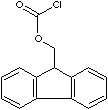| CAS
NO. |
28920-43-6 |

|
| EINECS
NO. |
249-313-6
|
| FORMULA |
C15H11ClO2 |
| MOL
WT. |
258.70 |
|
H.S.
CODE
|
2915.90
|
|
TOXICITY
|
|
| DERIVATION |
|
| SYNONYMS |
FMOC-chloride; 9-Fluorenylmethyloxycarbonyl
Chloride; |
|
Chloroformic acid 9-fluorenylmethyl ester;
9H-fluoren-9-ylmethyl chloroformate; Cloroformiato de
9H-fluoren-9-ilmetilo; Chloroformiate de 9H-fluorène-9-ylméthyle;
|
| DERIVATION |
|
|
CLASSIFICATION
|
|
|
PHYSICAL AND CHEMICAL PROPERTIES
|
| PHYSICAL
STATE |
white
to off-white powder
|
| MELTING POINT |
60 - 64 C |
| BOILING
POINT |
|
| SPECIFIC GRAVITY |
|
| SOLUBILITY
IN WATER |
Decomposes |
| pH |
|
| VAPOR DENSITY |
|
|
AUTOIGNITION
|
|
|
NFPA
RATINGS
|
|
|
REFRACTIVE
INDEX
|
|
| FLASH
POINT |
|
| STABILITY |
Stable
under ordinary conditions. Moisture sensitive. |
|
GENERAL
DESCRIPTION & APPLICATIONS
|
|
Amino acids bearing urethane-type protecting groups are commonly used in the
selective preparation of N-(9-fluorenylmethoxycarbonyl) derivatives of
hydroxy-amino acids. as they can be efficiently coupled without racemization.
They are prepared by Schotten-Baumann reaction using alkoxycarbonyl chlorides
except for N-tert-butoxycarbonylamino acids . An alternative reagent which does
not require the presence of base is the carbonates containing a substituted
phenolic group or succinimidyl group. Dipeptide formation is lower than with the
chloroformate, Fmoc-Cl. It has been employed in the synthesis of
glycopeptides.
Urethanes Protecting Groups: Urethanes find extensive use as protecting groups
for amines. These protecting groups are easily formed (see below) and can be
readily removed using the appropriate conditions. Several very popular urethane
protecting groups have been developed that withstand a variety of harsh reaction
conditions but are readily removed when subjected to mild acid, hydrogenolysis
or mild basic media. The different cleavage conditions of the above urethane
protecting groups has enabled so-called ‘orthogonal’ protection strategies to be
developed that enable selective chemistries to be performed upon different
amines present in the same molecule (http://users.ox.ac.uk/)
|
| SALES
SPECIFICATION |
|
APPEARANCE
|
white
to off-white powder
|
|
IDENTITY
[IR[
|
pass
|
|
PURITY
(HPLC)
|
97.0%
min
|
|
MELTING POINT |
60 - 64 C |
| TRANSPORTATION |
| PACKING |
|
| HAZARD CLASS |
8
(Packing Group: II) |
| UN
NO. |
1759 |
| OTHER
INFORMATION |
|
Hazard Symbols: T C, Risk Phrases: 20/22-34, Safety Phrases:
26-36/37/39-45 |
|
PRICE
INFORMATION
|
|
|
